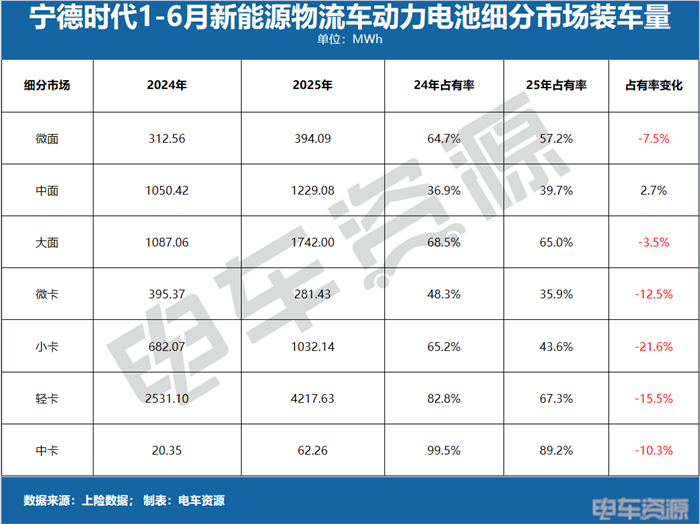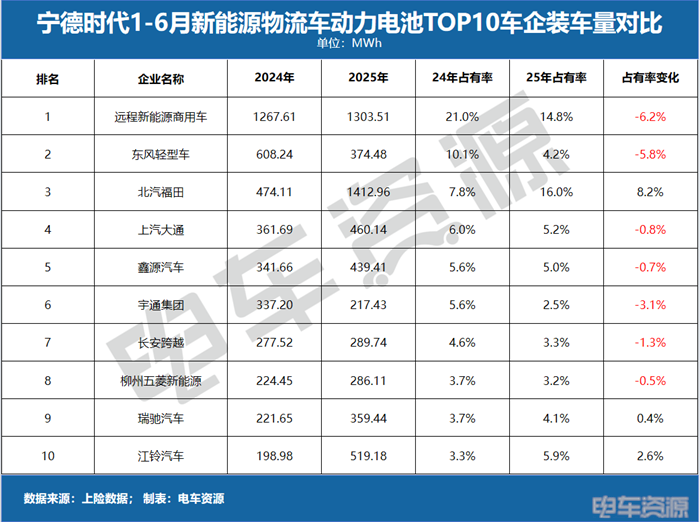CATL's Biggest Rival Is Its Customers
CATL is being "pulled away" by the market.
CATL's data on the installation volume of new energy logistics vehicle power batteries from January to June outlines a clear trajectory of market share changes. From mini vans to medium-duty trucks, the variations in market share across multiple segments convey a strong signal: CATL is experiencing a market "selective distancing."
In the micro van segment, the market share is 64.7% in 2024, dropping to 57.2% in 2025, a decline of 7.6% that marks the beginning of market changes; the micro truck, small truck, and light truck segments experience even greater declines in market share, with the small truck segment falling by 21.6% and the light truck segment by 15.5%, clearly reflecting a trend of being "drawn away" by more segmented markets.The dual changes in loading capacity data and market share reflect the weakening influence of CATL in the new energy logistics vehicle battery market, with its former "first-choice advantage" gradually being diluted by the market.

Looking at the comparison of installed volumes among the top 10 automakers, leading partners such as Farizon and Dongfeng have seen a decline in market share, with only a few automakers like BAIC Foton experiencing a slight increase. This indirectly confirms that CATL is being “selectively adjusted” by its partner automakers in terms of collaboration intensity for logistics vehicle battery supply. Its market dependence continues to decrease, further substantiating the trend of being “phased out by the market.”

The Automotive Industry's Breakaway: A Choice Driven by Costs, Risks, and the Pressure of Discourse Power and Brand Influence
New energy logistics vehicle companies have long been weighed down by the high battery costs from CATL. The proportion of battery costs in the total vehicle cost is too high, which severely squeezes the profit margins of car manufacturers. In the logistics vehicle industry, competitiveness comes down to cost-effectiveness during operations—every penny saved can determine whether a company survives. With the same budget, switching to another battery supplier can save a lot of money, so naturally, car manufacturers are making this “blood transfusion” decision. Since CATL is unwilling to share the costs with manufacturers, it can’t blame the market for voting with its feet.
Automakers have long been wary of the risks of "putting all their eggs in one basket." Even a slight fluctuation in CATL’s production capacity can immediately cause bottlenecks in vehicle manufacturing; its strong bargaining power also leaves automakers with no room to negotiate on capacity allocation or technical cooperation. Being controlled like this for the long term is hard for anyone to accept, so automakers have no choice but to actively "loosen the ties"—supporting second-tier suppliers and cultivating new battery players, all in an effort to break their dependence on CATL and fundamentally resolve potential supply chain issues.
The issue of capacity allocation has brought the rivalry between automakers and CATL into the open. When automakers are scrambling for market share, they are in urgent need of a steady "blood supply" of batteries, but CATL’s allocation schedule never seems to align with their demands. Leading automakers need to secure enough capacity to compete in the market, while small and medium-sized automakers find it even harder to get the resources they want. Rather than being led by the nose by CATL’s bargaining power, it’s better to look for new suppliers—what’s at stake is not just current capacity, but also the initiative to survive and thrive in the future.
What frustrates car manufacturers the most is that CATL's reputation is so overwhelming that it overshadows the car brands. Nowadays, when customers choose a car, the first question they ask is, "Does it have a CATL battery?" It seems as if the quality of the car itself and the technological capabilities of the car manufacturers are not important. Instead, the automakers have become "working for the battery." The cars they painstakingly build are regarded by customers as just "shells for CATL batteries," severely diminishing their brand presence. Who could be content with that? If this continues in the long term, how can car manufacturers maintain their brand identity? This sense of frustration has also become a hidden motivation for car companies to break away from CATL.
"Expensive" is just a facade; "suitability" is the essence.
When customers choose not to opt for models equipped with CATL batteries, their claim that it’s "expensive" is just a casual excuse; what they truly care about is whether the battery is suitable for their business needs.
For customers, when purchasing "money-making tools," their core thoughts revolve around whether it is "worth it, practical, and suitable." They are focused on how useful the tool can be, rather than the brand reputation of the battery. If a car equipped with a CATL battery is too expensive and exceeds the operational cost threshold, then it is obviously "not suitable." More importantly, customers have their own measure: does this battery suit their work? Those running short distances in the city might think that as long as the range is sufficient, there's no need to spend a lot on a high-range version. Meanwhile, those running long-distance routes might be more concerned about whether the range will significantly drop in winter or whether charging stations are easy to find. The same goes for after-sales service; if a repair takes half a month and delays work more than the money saved, then even the biggest brand is useless.
Once a more suitable battery appears on the market—for example, if those running cold chain logistics find a certain brand’s batteries perform more reliably at low temperatures, or city delivery drivers feel another brand has service centers right next to their homes—then no matter how famous CATL is, customers will still walk away. After all, for them, “suitability” means much more than “fame.”
Behind the game lies the beginning of an industry ecosystem reconstruction.
The changes in the new energy logistics vehicle battery market from January to June are far more than a simple shift in market shares; they represent a deep market game centered around cost, risk, bargaining power, and core needs. The heart of this contest, as revealed by the saying “CATL’s biggest rival is its customers,” is that as automakers proactively break free from the shackles of cost and supply chain risks, and as customers redefine their selection criteria with the word “suitability,” the former “battery giant dependence syndrome” is gradually being overcome by the market’s self-healing capability.
For CATL, the decline in market share is not the end, but a clear signal from the industry — in the field of new energy logistics vehicles, which highly relies on "pragmatism," the selection logic of customers (whether car manufacturers or B-end customers) has returned to its essence: car manufacturers seek controllable costs, independent supply chains, and brand independence, while customers want cost-effectiveness and suitability that align with operational scenarios.
The ultimate direction of this game is the rebalancing of the new energy logistics vehicle industry ecosystem. It signifies that the relationship between battery manufacturers and vehicle companies will shift from “one-way supply” to “symbiotic collaboration.” The rise of second-tier battery enterprises will break the monopoly, stimulate industry innovation, and the genuine needs of end customers will become the core driving force for the evolution of the industry chain. For the entire industry, this may not be the “decline” of a particular enterprise, but rather the beginning of a more mature and healthier market ecosystem. In the context of diversified competition, only an industry chain with better cost efficiency, more suitable technology, and more precise services can truly support the long-term development of the new energy logistics vehicle industry.
【Copyright and Disclaimer】The above information is collected and organized by PlastMatch. The copyright belongs to the original author. This article is reprinted for the purpose of providing more information, and it does not imply that PlastMatch endorses the views expressed in the article or guarantees its accuracy. If there are any errors in the source attribution or if your legitimate rights have been infringed, please contact us, and we will promptly correct or remove the content. If other media, websites, or individuals use the aforementioned content, they must clearly indicate the original source and origin of the work and assume legal responsibility on their own.
Most Popular
-

List Released! Mexico Announces 50% Tariff On 1,371 China Product Categories
-

Nissan Cuts Production of New Leaf EV in Half Due to Battery Shortage
-

New Breakthrough in Domestic Adiponitrile! Observing the Rise of China's Nylon Industry Chain from Tianchen Qixiang's Production
-

Dow, Wanhua, Huntsman Intensively Raise Prices! Who Controls the Global MDI Prices?
-

Clariant Unveils Cost-Cutting Plan Details, Plans to Shut Down Multiple Plants






